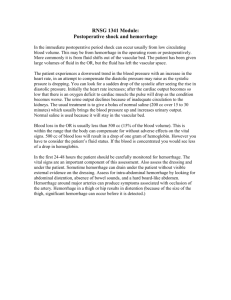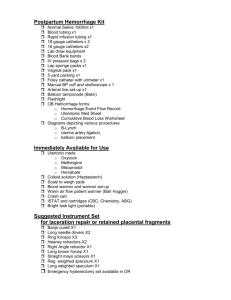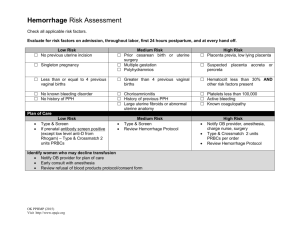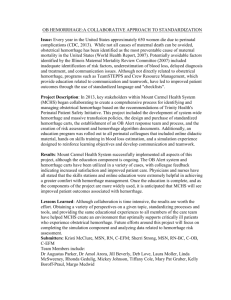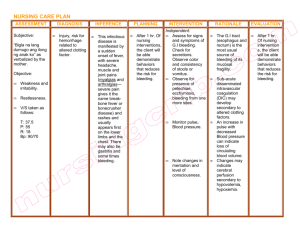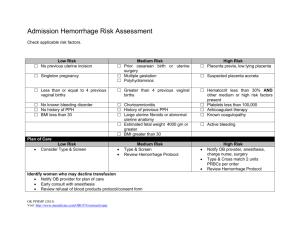Hemorrhage
advertisement
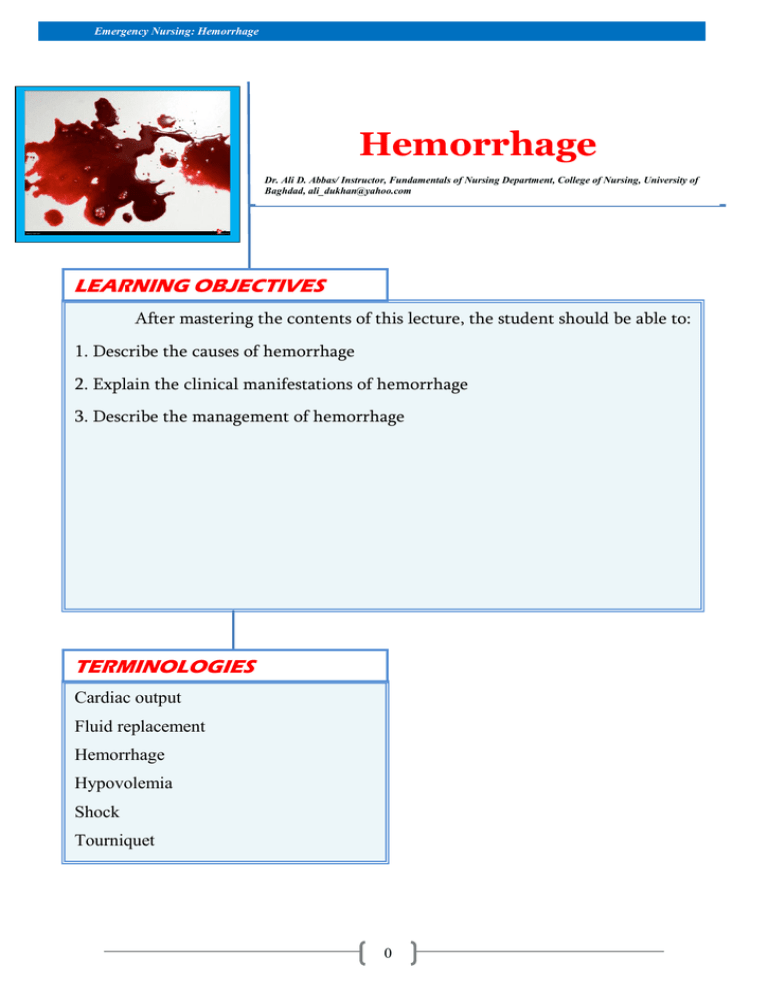
Emergency Nursing: Hemorrhage Hemorrhage Dr. Ali D. Abbas/ Instructor, Fundamentals of Nursing Department, College of Nursing, University of Baghdad, ali_dukhan@yahoo.com LEARNING OBJECTIVES After mastering the contents of this lecture, the student should be able to: 1. Describe the causes of hemorrhage 2. Explain the clinical manifestations of hemorrhage 3. Describe the management of hemorrhage TERMINOLOGIES Cardiac output Fluid replacement Hemorrhage Hypovolemia Shock Tourniquet 0 Emergency Nursing: Hemorrhage CONTENTS 1. Hemorrhage 2. Causes of Hemorrhage 3. Clinical Manifestations 4. Management 5. References 1 Emergency Nursing: Hemorrhage 1. Hemorrhage Stopping bleeding is essential to the care and survival of patients in an emergency or disaster situation. Hemorrhage that results in the reduction of circulating blood volume is a primary cause of shock. Minor bleeding, which is usually venous, generally stops spontaneously unless the patient has a bleeding disorder or has been taking anticoagulants. 2. Causes of Hemorrhage: Hemorrhage arises due to traumatic injury, underlying medical condition, or a combination. 1. Traumatic Injury Traumatic bleeding is caused by some type of injury. There are different types of wounds which may cause traumatic bleeding. These include: Abrasion, Excoriation, Hematoma, Laceration, Incision, Puncture Wound, Contusion, Crushing Injuries , and Ballistic Trauma. 2. Medical condition 'Medical bleeding' denotes hemorrhage as a result of an underlying medical condition (i.e. causes of bleeding that are not directly due to trauma). Blood can escape from blood vessels as a result of three basic patterns of injury: Intravascular changes - changes of the blood within vessels (e.g. ↑ blood pressure, ↓ clotting factors) Intramural changes - changes arising within the walls of blood vessels vessels (e.g. H (e.g. aneurysms, dissections, vasculitides) Extravascular changes - changes arising outside pylori infection, brain abscess, brain tumor) 3. Clinical Manifestations: The patient is assessed for signs and symptoms of shock: Cool, Moist skin (resulting from poor peripheral perfusion), Decreasing blood pressure, Increasing heart rate, Delayed capillary refill, Decreasing urine volume 2 blood Emergency Nursing: Hemorrhage 4. Management: The goals of emergency management are to: Control the bleeding, Maintain adequate circulating blood volume for tissue oxygenation, Prevent shock Note / Patients who hemorrhage are at risk for cardiac arrest caused by hypovolemia with secondary anoxia. Note / hemorrhaging whether externally or internally a loss of circulating blood results in a fluid volume deficit and decreased cardiac output Steps of management: 1. Control of bleeding 2. Fluid replacement is imperative to maintain circulation (two large gauge IV catheters are inserted to provide a means for fluid and blood replacement) 3. Blood samples are obtained for analysis, typing, and cross-matching. Note / Replacement fluids are administered as prescribed, depending on clinical estimates of the type and volume of fluid lost. Replacement fluids may include: Isotonic electrolyte solutions (eg, lactated Ringer’s, normal saline), Colloids, Blood component therapy (Packed red blood cells are infused when there is massive blood loss, which may also necessitate transfusion of other blood components, including platelets and clotting factors) Note / The infusion rate is determined by the severity of the blood loss and the clinical evidence of hypovolemia. Note / If massive blood replacement is necessary, the blood must be warmed in a commercial blood warmer, because administration of large amounts of blood that has been refrigerated has a core cooling effect that may lead to cardiac arrest and coagulopathy. 3 Emergency Nursing: Hemorrhage Control of External Hemorrhage If a patient is hemorrhaging externally (eg, from a wound), 1. The patient’s clothing is cut away in an attempt to identify the area of hemorrhage. 2. Direct, firm pressure is applied over the bleeding area or the involved artery at a site that is proximal to the wound (Fig. 1). 3. Otherwise, unchecked arterial bleeding results in death. A firm pressure dressing is applied, and the injured part is elevated to stop venous and capillary bleeding if possible. 4. If the injured area is an extremity, the extremity is immobilized to control blood loss. A tourniquet is applied to an extremity only as a last resort when the external hemorrhage cannot be controlled in any other way and immediate surgery is not feasible. Note / Care must be taken when applying a tourniquet because of the risk of loss of the extremity. The tourniquet is applied just proximal to the wound and tied tightly enough to control arterial blood flow. The patient is tagged with a skin marking pencil or on adhesive tape on the forehead with a “T,” stating the location of the tourniquet and the time applied. 5. If there is no arterial bleeding, the tourniquet is removed and a pressure dressing is applied. 6. If the patient has suffered a traumatic amputation with uncontrollable hemorrhage, the tourniquet remains in place until the patient is in the operating room. Figure.1 Pressure points for control of hemorrhage 4 Emergency Nursing: Hemorrhage Control of Internal Bleeding If the patient shows no external signs of bleeding but exhibits tachycardia, falling blood pressure, thirst, apprehension, cool and moist skin, or delayed capillary refill, internal hemorrhage is suspected. 1. Packed red blood cells are administered at a rapid rate, 2. The patient is prepared for more definitive treatment (eg, surgery, pharmacologic therapy). 3. Arterial blood gas specimens are obtained to evaluate pulmonary function and tissue perfusion and to establish baseline hemodynamic parameters, which are then used as an index for determining the amount of fluid replacement the patient can tolerate and the response to therapy. 4. The patient is maintained in the supine position. 5. Monitored closely until hemodynamic or circulatory parameters improve, or until he or she is transported to the operating room or intensive care unit. 5. References: Smeltzer, S.; Bare, B.; Hinkle, J.; and Cheever, K.: Textbook of MedicalSurgical Nursing, 12th ed., 2010, Philadelphia: Lippincott Williams and Wilkins .P.P.2161-2163. 5
